How Individual Identity Influences The Way Audiences Share [Survey Data]
- Fahad H

- Nov 12, 2014
- 6 min read
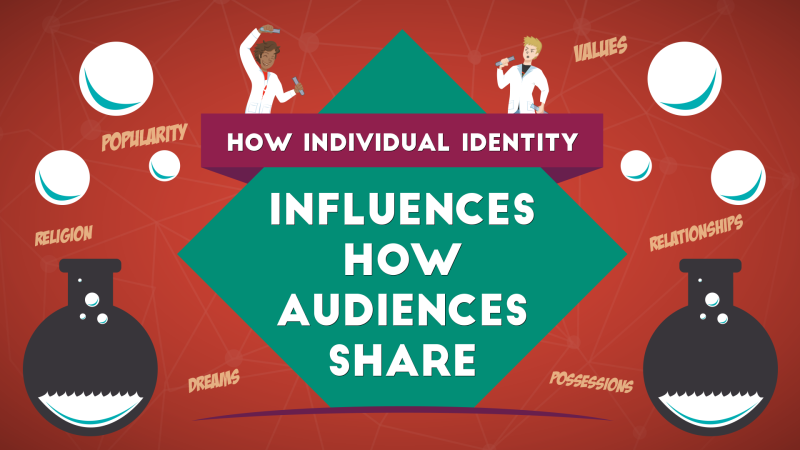
From content influencers to “lurkers,” the content that people choose to share online has come to play a major role in how they curate their self-image and control how they present themselves to others online.
But what makes a person identify with a piece of content? Which aspects of their personal identity are more effective at enticing users to share it?
Understanding this complex relationship is the key to understanding users’ engagement with content — or lack thereof. Nobody knows this better than BuzzFeed, the internet’s most successful publisher.
BuzzFeed founder Jonah Peretti built the site around the idea that one of the ways people form their self-identity is by appropriating and incorporating cultural artifacts from media (such as songs, movies, TV shows, etc.). In the internet age, those types of cultural artifacts take the form of memes, tweets, and social media posts.
That’s where content creators come in. The challenge for a content creator wading into the torrent of social media noise is to produce content that helps people discover shared experiences, common values, and collective identities — to produce cultural artifacts that people will want to appropriate and incorporate into their individual identities.
In other words, to create content that helps people talk to one another in the new “language” of social media sharing.
To get an idea of how people view and construct their identity through sharing on social media, we surveyed more than 1,000 people about different aspects of their online sharing habits and motivations with regard to personal identity.
We asked them to rate the importance of different aspects of identity when sharing on social media, followed by specific questions about their actual sharing behavior. We also analyzed the results according to gender and age group to get some deeper insights.
Aspects Of Identity
Our survey focused on the five broad aspects that make up individual identities, as identified by social scientists. They are:
Personal – relating to values, dreams, goals, and emotions
Relational – relating to relationships, commitment to partners, and close friendships
Social – relating to popularity, reactions from others, and physical appearance
Collective – relating to one’s generation, race, and religion
Superficial – relating to things one owns, age, and gender
While each of these categories goes into an individual identity, they’re not all necessarily equally important.
In his paper, “Identity Salience and Identity Importance in Identity Theory,” Dr. R.C. Morris of Purdue University explained that according to identity theory, we rank the many aspects of our identities in a hierarchy. The higher an identity is ranked, and the larger and more important the social network associated with that identity, the more likely it is that we will take action to strengthen or reinforce that identity.
So, which identities are most important to users on social networks? On a scale of 1–5, survey participants ranked their relational and personal identities as most important to them when sharing content on social media.
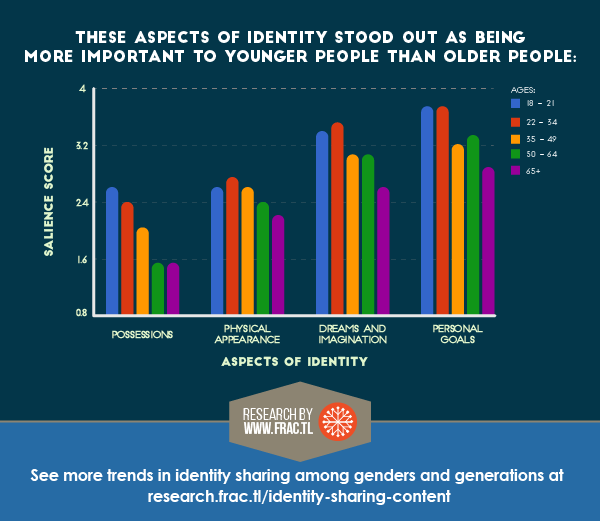
Relational Identity
When it comes to sharing content online, 84% of all participants said “relationships” and “being a good friend to those I care about” are important to them. More than 20% said these factors are “extremely important,” giving them the highest possible rating.
Relational identities were the most important to the oldest age group in our study; those in the 65+ age category ranked their relationships with others much higher than any other factor in the survey.
Personal Identity
This aspect of identity involves a person’s inner life, beliefs, imagination, and emotions. On average, survey participants ranked this category second-most important to their sharing habits; 63% of participants ranked their personal values and moral standards as very or extremely important when they shared content online.
We also found that younger people rated this personal aspect of identity slightly higher, and its importance decreased as the age groups get older. Both younger and older Millennials (ages 18–34) ranked their dreams, imagination, and goals higher than their older counterparts.
Social Identity
Social identity – involving popularity, reactions from others, and physical appearance – was the third most important to all participants. Men tended to rank this aspect slightly higher than women, with 41% of men saying popularity was at least somewhat important, compared with 37% of women.
Younger participants, including Millennials and Generation Xers (ages 18–50) placed more importance on their physical appearance, while the oldest age groups (ages 51 and above) gave it very little importance.
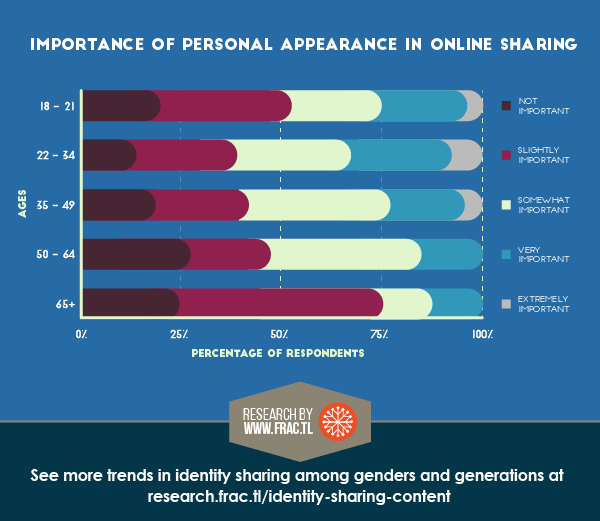
Superficial Identity
Most participants said they did not care much about the superficial aspects of their identity online. Material possessions, age, and gender ranked second-lowest in our survey. Fewer than 30% said their sex or age was important. This may reflect the fact that the most superficial aspects of our identities are also the easiest to conceal on the internet.
Fewer than 35% said their possessions — the things they own — were important in their content sharing. However, men and younger respondents ranked possessions higher than other groups, with 31% of younger Millennials, 16% of older Millennials, and 16% of men ranking possessions as “very” or “extremely” important.
Collective Identity
Factors relating to generation, race, and religion ranked as the lowest considerations in online sharing behavior. Fewer than 10% of all participants ranked any collective identity factor as “extremely important.”
Older users – those over the age of 35 – ranked being a member of their generation higher than younger users, with Baby Boomers ranking this factor most highly. This reflects the fact that older generations are more likely to be aware of generational shifts in values.
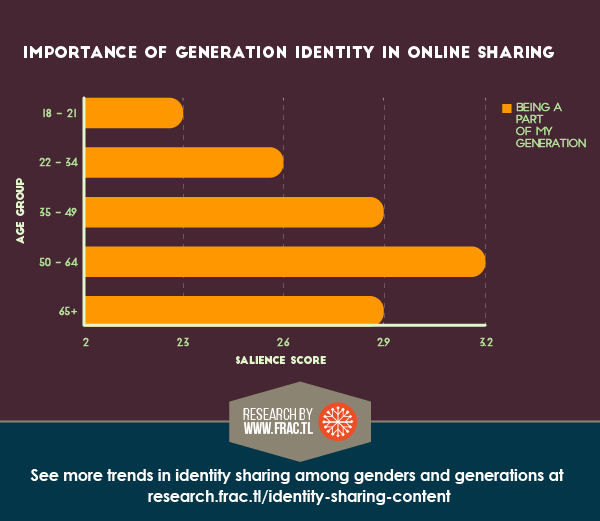
The least important factor that users consider when sharing content online? Religion. 55% of survey respondents said this factor was “not important.”
Sharing Behavior
Our survey showed that social media use was common and ubiquitous across all age groups. More than 85% said they posted on social media at least once a week. 68% of participants said they had posted on social media between 1–7 times in the past week. 42% said 1–3 of their posts were articles or media from third-party online publishers.
Surprisingly, those in the youngest generation (age 18–21) were least likely to share on social media; 21% of that age group said they hadn’t posted at all in the past week, and 53% said they had not shared content from any online publishers. The oldest respondents (ages 65 and above) were the next least likely to share third-party content; 50% said they hadn’t shared content from publishers in the past week.
Men reported sharing more often on social media than women. But women expect more engagement from their friends: 68% of women expect 11 or more likes or comments on their Facebook posts, compared with 61% of men.
Similarly, Baby Boomers (ages 41–65) said they expect more engagement from their friends than other age groups did. More than 30% of older Millennials and those age 51 and older expect to receive 11 more likes or comments, compared with less than a quarter of younger Millennials and Gen Xers.
But, receiving fewer than the anticipated amount of likes or comments does not significantly impact whether users will reshare similar content, our survey found.
Eighty-nine percent (89%) of women and 87% of men said there was as least some likelihood they would post similar content in the future, and nearly 10% of both men and women said they “definitely will,” regardless of engagement. Similarly, Baby Boomers were more likely than other age groups to share similar content again, regardless of engagement.
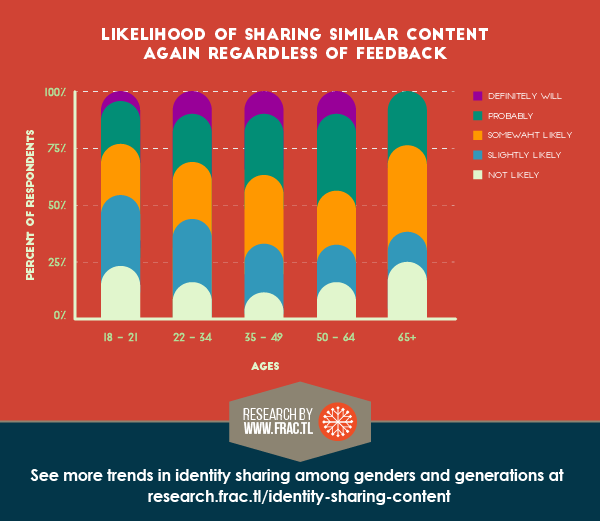
Motivations For Sharing
When we asked participants to rank their most important motivation for sharing on social media, one answer dominated all others: they want to entertain. 44% of respondents ranked entertainment as their top motivation for sharing, followed by education in a distant second at 25%. The third most important motivation for sharing was “to share something that is a reflection of who I am,” which was most important to 20% of users.
Very few (about 10%) said they shared content in order to “show support for a cause.” And the motivation “to learn about people” on the social network barely registered as important with any respondents.
Motivations for sharing varied slightly by gender. In general, women share more altruistically than men. Of the last five articles they shared, 44% of women and 27% of men shared content to show their support for a cause. However, only 13% of women and 8% of men said altruism was “most important” to them when they shared content.
Similarly, younger people tended to place the least importance on showing support for a cause. Fewer than 10% of all respondents under the age of 50 ranked causes as important, while that number jumped to 20% for ages 51-65 and 37% for ages 65+.
Conclusion
When we asked users about sharing specific articles, they were far more likely to share the most entertaining and least personal content. At the same time, they were least likely to share content with the highest potential controversy, moral valence, or value judgments.
The social aspects of social networks (relationships, being a good friend) dominate people’s use of social media, and they figure most prominently into people’s motivations for sharing third-party content. The more individualist aspects of personal identity (personal goals and hopes, imagination) rank lower, but they are still important drivers of social media shares. The most specific and superficial categories (race, gender, religion) have the least effect on broad sharing behavior.
So users are keenly aware that using social media is a primarily social act that involves other people and is likely to have an effect on others. Their most preferred effect is to entertain – by far the most dominant motivation for sharing – followed by education. These, too, are the most social motivations for sharing – they inherently have an effect on others.
As social media allows user to construct their identity, users are aware that it is an inherently social identity. Users appear to want to project an open, humorous, welcoming, and entertaining persona – and are looking for content to help them achieve that goal.








Comments